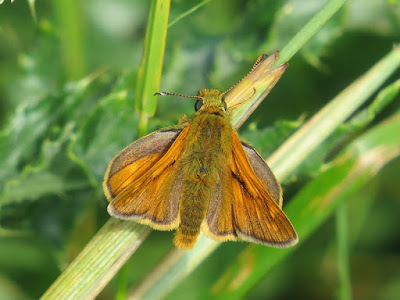Today was our "steel" wedding anniversary. What lovely romantic idea could I come up with to celebrate it? I know, I thought, take Lyn to Upton Warren to see the Avocets.
I have always wondered how do-able the Flashes might be. For those who might not be aware, Lyn has mobility problems which have left her restricted to a wheelchair. My most recent visit to Upton Warren left me impressed by the improvements they have made, and optimistic that we could share the wildlife spectacle.
So how did we get on? Well the good news is that we are still alive, just.
I had been talking to Alistair at the sailing club, and he very kindly agreed I could drive to the top of the steps. Steps ? Oh yes, the first obstacle. They looked quite shallow and broad, though containing a bend to the left, and I was confident we could get down them, which we did. After that, the only issue was overhanging nettles as we trundled along the narrow boardwalk, then over rough ground, and more boardwalk to the accessible main hide.
Once in the hide I moved the movable benches before realising I hadn't considered that the slats were too high for someone sitting in a wheelchair (unlike in the concrete hide at the Moors Pool). So a bit of a minus point for the reserve I'm afraid, but nevertheless with a bit of effort Lyn managed to get onto the bench and the birding could begin.
The best thing about this hide is how close you are to the birds. Avocets, Black-headed Gulls, Lapwings, all with chicks, just yards away. The highlight was the discovery that the Little Ringed Plovers have bred, and one extremely cute chick was showing well, sometimes.
 |
| Little Ringed Plover with chick (not showing at all well) |
A 22-spot Ladybird decided to join us in the hide.
As the weather was showing signs of going downhill, we decided to make tracks. There was still time to take a few more photographs.
 |
| possibly Pyrochroa serraticornis |
Then we got to the steps. A lot harder going up than down. I first tried going up forwards, but after the second step I found I was having trouble getting purchase on the gravel which each step was composed of, so I did a 180 degree turn, briefly tipping the left wheel of the wheelchair off the step in the process. At this point Lyn sustained a slight injury (nettle stings) but our dignity was intact. I eventually succeeded in hauling the chair backwards and got to the top step. The gate at the top opened towards me, a bit of a problem. More huffing and puffing and we got through.
I was now definitely a heart-attack candidate, while Lyn was trying to overcome the onset of a nervous breakdown, but we had done it. Upton Warren Flashes is possible in a wheelchair. Don't think we'll be back though.
Happy anniversary darling.
















































